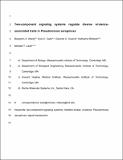| dc.contributor.author | Wang, Benjamin X | |
| dc.contributor.author | Cady, Kyle | |
| dc.contributor.author | Carcamo Oyarce, Gerardo Alejandro | |
| dc.contributor.author | Ribbeck, Katharina | |
| dc.contributor.author | Laub, Michael T | |
| dc.date.accessioned | 2021-08-05T20:52:43Z | |
| dc.date.available | 2021-08-05T20:52:43Z | |
| dc.date.issued | 2021-05 | |
| dc.identifier.issn | 0099-2240 | |
| dc.identifier.issn | 1098-5336 | |
| dc.identifier.uri | https://hdl.handle.net/1721.1/131143 | |
| dc.description.abstract | Pseudomonas aeruginosa is an opportunistic pathogen that can cause problematic infections at different sites throughout the human body. P. aeruginosa encodes a large suite of over 60 two-component signaling systems that enable cells to rapidly sense and respond to external signals. Previous work has shown that some of these sensory systems contribute to P. aeruginosa pathogenesis, but the virulence-associated processes and phenotypic traits that each of these systems controls are still largely unclear. To aid investigations of these sensory systems, we have generated deletion strains for each of 64 genes encoding histidine kinases and one histidine phosphotransferase in P. aeruginosa PA14. We carried out initial phenotypic characterizations of this collection by assaying these mutants for over a dozen virulence-associated traits, and we found that each of these phenotypes is regulated by multiple sensory systems. Our work highlights the usefulness of this collection for further studies of P. aeruginosa two-component signaling systems and provides insight into how these systems may contribute to P. aeruginosa infection. | en_US |
| dc.description.sponsorship | NIBIB/NIH (Award R01-EB017755) | en_US |
| dc.description.sponsorship | National Science Foundation (Award PHY-1454673) | en_US |
| dc.description.sponsorship | National Science Foundation (Award PHY-1454673 and Grant 1745302) | en_US |
| dc.description.sponsorship | U.S. Army Research Office (Contract W911NF-19-2-0026) | en_US |
| dc.description.sponsorship | NIH (Grant R01-GM082899) | en_US |
| dc.language.iso | en | |
| dc.publisher | American Society for Microbiology | en_US |
| dc.relation.isversionof | http://dx.doi.org/10.1128/aem.03089-20 | en_US |
| dc.rights | Creative Commons Attribution-Noncommercial-Share Alike | en_US |
| dc.rights.uri | http://creativecommons.org/licenses/by-nc-sa/4.0/ | en_US |
| dc.source | Prof. Laub | en_US |
| dc.title | Two-Component Signaling Systems Regulate Diverse Virulence-Associated Traits in Pseudomonas aeruginosa | en_US |
| dc.type | Article | en_US |
| dc.identifier.citation | Wang, Benjamin X et al. "Two-Component Signaling Systems Regulate Diverse Virulence-Associated Traits in Pseudomonas aeruginosa." Applied and Environmental Microbiology 87, 11 (May 2021): dx.doi.org/10.1128/aem.03089-20. | en_US |
| dc.contributor.department | Massachusetts Institute of Technology. Department of Biology | en_US |
| dc.contributor.department | Massachusetts Institute of Technology. Department of Biological Engineering | en_US |
| dc.relation.journal | Applied and Environmental Microbiology | en_US |
| dc.eprint.version | Author's final manuscript | en_US |
| dc.type.uri | http://purl.org/eprint/type/JournalArticle | en_US |
| eprint.status | http://purl.org/eprint/status/PeerReviewed | en_US |
| dc.date.updated | 2021-08-05T17:48:16Z | |
| dspace.orderedauthors | Wang, BX; Cady, KC; Oyarce, GC; Ribbeck, K; Laub, MT | en_US |
| dspace.date.submission | 2021-08-05T17:48:18Z | |
| mit.journal.volume | 87 | en_US |
| mit.journal.issue | 11 | en_US |
| mit.license | OPEN_ACCESS_POLICY | |
| mit.metadata.status | Complete | |
